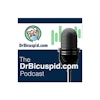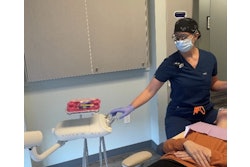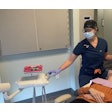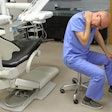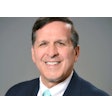Targeted posture-correction exercises combined with kinesiology taping (KT) may improve dentists’ posture, potentially enhancing their professional performance, according to a study recently published in Health Science Reports.
This intervention led to reduced forward head posture (FHP) and shoulder rounding, suggesting it may lower the risk of musculoskeletal complications, the authors wrote.
“Dentists' postural alignment significantly improved when a comprehensive corrective exercise was implemented together with concurrent KT of the thoracic and scapular regions,” wrote the authors, led by Zahra Fadaei Forghan of the University of Guilan Department of Sports Injuries and Corrective Exercises in Iran (Health Sci Rep, September 12, 2025, Vol. 8:9, e71242).
Exercise therapy is a common treatment for musculoskeletal disorders, with KT helping to transmit corrective signals to the nervous system by restricting harmful movements and enhancing exercise effects. Dentists have a high risk of developing musculoskeletal problems, particularly postural issues. This study aimed to explore how combining KT with exercise therapy might improve posture, mobility, and overall performance in dentists.
This quasi-experimental study used a pretest/post-test control group design, including dentists with over five years of experience. A total of 30 participants with FHD (angle > 46°) were randomly assigned to either an experimental or a control group. The experimental group completed an eight-week program of corrective exercises combined with KT performed three times per week, they wrote.
The exercise protocol entailed releasing, lengthening, activating, and integrating postural muscles while KT was applied in a U-shape to the upper trapezius and cervical spine to help maintain proper posture. Both FHP and kyphosis angle were measured before and after the study.
The combined intervention significantly improved dentists’ posture compared to the control group. Interaction effects were strong for FHP (F = 44.54, p = 0.001, effect size [ES] = 0.61), kyphosis (F = 44.79, p = 0.001, ES = 0.61), rounded shoulders (F = 8.34, p = 0.007, ES = 0.23), and scapular positions at 0° (F = 22.81, p = 0.001, ES = 0.44), 45° (F = 16.09, p = 0.001, ES = 0.36), and 90° (F = 13.47, p = 0.001, ES = 0.32), Forghan and co-author Parisa Sedaghati wrote.
Post hoc tests showed significant pre to post improvements in all variables in the experimental group, while the control group had smaller changes only in FHP, kyphosis, and scapular positions at 0° and 45°. The main effects of time were significant only for FHP (F = 7.87, p = 0.009, ES = 0.22), and the main effects of the group were significant for FHP, rounded shoulders, and scapular position at 90°.
The study had limitations. The lack of a placebo taping group made it difficult to separate the true physiological effects of KT from participants’ expectations, the authors noted.
“These findings can serve as a basis for designing targeted preventive and therapeutic programs for dentists and other professionals who are exposed to long-term static positions and are at risk of postural abnormalities,” Forghan and Sedaghati concluded.


